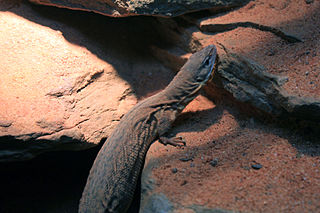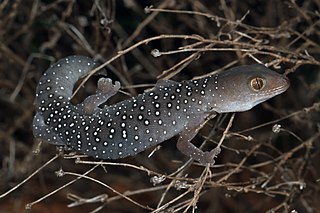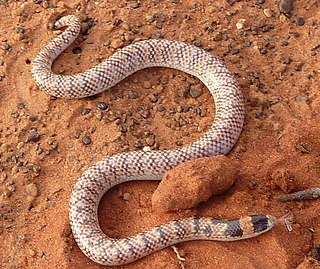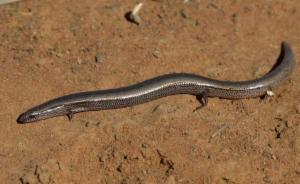
The southern ningaui is a tiny marsupial carnivore belonging to the Dasyuridae family. Similar in appearance to Ningaui ridei, found throughout central Australia, this species occurs in spinifex on semi-arid sandplains across the southern coast of the continent. The fur is a tawny or greyish olive colour, light grey below, and distinguished by shades of cinnamon. The southern ningaui prefers smaller prey, including insects and spiders, but capable of killing and consuming larger animals such as cockroaches and skinks. Their narrow muzzle is used with quick and fierce bites about the head to despatch their meal. The species was first described in 1983, and placed within the genus Ningaui.

The sandhill dunnart is a species of carnivorous Australian marsupial of the family Dasyuridae. It is known from four scattered semi-arid areas of Australia: near Lake Amadeus in Northern Territory, the central and eastern Eyre Peninsula in South Australia, the southwestern and western edges of the Great Victoria Desert in Western Australia, and at Yellabinna in South Australia.

The sandy inland mouse is a species of rodent in the family Muridae. Also known as the Hermannsburg (Mission) false-mouse or Hermannsburg mouse, it is endemic to Australia and found widely yet sparsely through arid and semi-arid areas.

Menetia greyii, commonly known as the common dwarf skink or Grey's skink, is a species of lizard in the family Scincidae. The species is native to mainland Australia and Indonesia.

The central netted dragon or central netted ground dragon is a species of agamid lizard occurring in a wide range of arid to semiarid regions of Australia. It is widespread across the continent, commonly found in open, sandy, desert habitats. It is a popular pet and can often be found in zoos.

Storr's monitor is a species of monitor lizard in the family Varanidae. The species is endemic to Australia.

Strophurus elderi, also known commonly as the jewelled gecko, is a terrestrial, nocturnal species of gecko, a lizard in the family Diplodactylidae. Previously classified within the genus Diplodactylus, S. elderi is one of 22 geckos belonging to the genus Strophurus. The species is endemic to the arid regions of central and north-western Australia.

The Mallee dragon, also commonly known as the Mallee dragon and the Mallee sand-dragon, is a species of lizard in the family Agamidae. The species is native to the arid parts of southern Australia.
The wood mulch-slider or Mueller's three-toed lerista, is a species of lizard belonging to the extensive family Scincidae, a family containing over 1,500 species. The species is found in a diverse range of climates and habitats throughout Western Australia, Northern Territory, Queensland, New South Wales, South Australia and Victoria. Named after the German-born Australian naturalist Baron Ferdinand Jacob Heinrich Müller (1825–1896), the species has been the subject of much morphological and nomenclature debate.

Brachyurophis fasciolatus is a species of snake from the family Elapidae, commonly named the narrow-banded shovel-nosed snake, or narrow-banded burrowing snake, and is a species endemic to Australia. Its common names reflect its shovel nose specialization, burrowing behaviour and banded body colour.

The desert egernia, unadorned desert-skink or desert skink is a species of skink, a lizard in the family Scincidae. The desert egernia is endemic to the continent of Australia, and is widespread, with populations recorded in all mainland states and territories except the Australian Capital Territory. The desert egernia is found in dry, desert areas with deep, uncompacted sandy/loamy soils and little significant vegetation cover.
The Southern Mallee ctenotus is a medium sized lizard in the family scincidae (skink) found in the central and southern interior regions of South Australia and Western Australia; the Mallee regions of NSW and Victoria, in Australia.

Ctenotus leonhardii, known by the common names Leonhardi's ctenotus, Leonhardi's skink or common desert ctenotus, is a species of skink found in a range of arid and semi-arid regions throughout mainland Australia. The species was named after German anthropologist Moritz von Leonhardi in 1919 and belongs to the genus Ctenotus, one of the largest genera of lizards in Australia.

The broad-banded sand-swimmer or Richardson's skink is a species of skink found in Australia.
Lerista griffini, also known commonly as Griffin's lerista and the stout sandslider, is a species of skink, a lizard in the family Scincidae. The species is endemic to Australia.
Lerista ingrami, also known commonly as the McIvor River slider, is a species of skink, a lizard in the family Scincidae. The species is endemic to Queensland in Australia.
Lerista kendricki, also known commonly as the dark broad-blazed slider and the Shark Bay broad-striped slider, is a species of skink, a lizard in the subfamily Sphenomorphinae of the family Scincidae. The species is endemic to the Australian state of Western Australia.
The eastern robust slider is a nocturnal, burrowing species of skink found in continental Australia. Other common names are 'spotted lerista', and 'common burrowing skink'. The earliest written description of the species was provided by Albert Günther in 1867, based on a specimen caught in Queensland.

Lerista timida, the dwarf three-toed slider or wood mulch-slider, is a species of skink found in Australia. Other common names for the species include timid slider and dwarf burrowing skink. The skink is a member of the Lerista genus which are confined to continental Australia and are mostly a burrowing species of skink. The genus consists of consists elongated, smooth-scaled, Fossorial lizards that are specialized for life in the upper soils and dry leaf litter through which they slide using Lateral undulation as a form of locomotive action, giving rise to their nickname as sliders. They normally emerge of a night-time to hunt for small Invertebrates such as ants, termites and insects. If disturbed, they dive immediately into any loose substrate to avoid predation, this behavior leaves behind a distinctive disrupted wavy track that often found on sandy flats or dunes, roads and tracks.
The yellow-tailed plain slider is a species of skink located primarily in the desert areas of South Australia, Western Australia, Northern Territory and New South Wales in Australia. This uncommon lizard can be identified by its bright yellow tail, and is usually found buried under loose soil, tree stumps and leaf litter.















